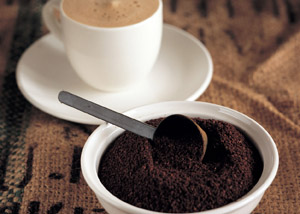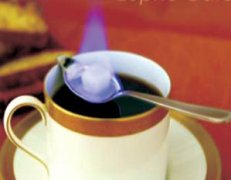A brief introduction to the treatment method of grinding degree and baking degree of Indonesian Mantenin boutique coffee beans with a little sweetness

The processing process and Sumatran characteristics. I describe these treatments in such detail because it is not clear how the soil and atmosphere and the unusual treatment techniques and the three-stage drying each affect the formation of the characteristics of Lindong and Manning coffee. Only one thing is certain. These treatments occasionally produce excellent coffee and are extremely unstable. Only through the merciless selection in the Medan port exporter's warehouse can the deep texture and unique and low-key rich taste of Lintong Lindong and Mandheling Mantenin emerge from the interference of other smells.
Manning Coffee is produced in Sumatra, Indonesia, Asia, also known as "Sumatran Coffee". The main producing areas are Java, Sulawesi and Sumatra, 90% of which are Robusta species. Among them, the "Manning" produced in Sumatra is the most famous. The best of the exquisite traditional Arabica coffee produced in northern Sumatra of Sumatra is sold as Lindong Lintong and Manning Mandheling. To be exact, Lindong Lintong refers to the coffee growing in a small area in the southwest of Toba Lake in Lindong District. Its flavor is very rich, fragrant, bitter, mellow, with a little sweetness. Most coffee lovers drink on their own, but it is also an indispensable variety for blending coffee.
Mantenin has a strong taste, with a strong mellow and rich and lively sense of movement, neither astringent nor sour, mellow and bitter can be fully revealed. The appearance of Mantenin coffee beans is arguably the ugliest, but coffee fans say that the worse the Sumatran coffee beans are, the better, mellow and slippery they are.
Manning needs layers of screening, which I think is absolutely necessary. The probability of defective beans is too high, coupled with the ugly appearance, sometimes good beans look like defective beans. Every time I pick Mantenin, I can pick out a handful of defective beans, look back in the defective beans, and feel that it is not defective beans, it looks like this.
However, after baking, Mantenin is like a caterpillar breaking its cocoon into a butterfly. The cooked beans are very full and look quite pleasing to the eye. It has bought almost all the best producing areas in Indonesia, so most of the beans from PWN are unique boutiques. Gold Mantning is the product produced by this company. After the acquisition of raw beans, the beans are selected by hand to select the full and flawless beans. Finally, these beans can be divided into Golden Manning as if they had gone through the draft. However, PWN registered the gold manning as a trademark, that is to say, only the gold manning produced by PWN can be regarded as the real "golden manning". Many of the beans on the market that are not made by PWN and hang the gold manning brand should actually be called boutique manning. "Golden Manning", it is not an old bean, but a product named by the company.
Gold mantenin tastes cleaner than Lindong mantenin. Mantenin's original herbal, earthy and woody flavors are almost gone, but caramel is more sweet and fruity is brighter and more elegant.
Manning coffee is considered to be the most mellow coffee in the world. When tasting Mantenin, you can feel obvious lubrication on the tip of the tongue and low acidity, but this acidity can also be obviously tasted. Leaping slight acid mixed with the richest aroma, so that you can easily feel the lively factor in the mild fragrance. In addition, this coffee has a faint earthy aroma, and some people describe it as the aroma of herbs.
Generally, Lin Dong Mantenin bakes until the second explosion and then comes out of the oven, which can reduce the miscellaneous smell, but the gold Mantenin has a good transparency and sweetness before or after the second explosion, and the baking interpretation space is wider. Mantenin's unique herbal aroma and sunwood flavor. Due to high humidity, the pectin layer is dried in three stages. This is also a rare treatment in the world, accidentally creating a low-acid, thick and smelly flavor of Mantenin. Due to the variety of three-stage drying method and rough processing techniques, Manning can be called the most unstable boutique coffee. Chopped beans, moldy beans, black beans and unripe beans are so full of bakers that it takes a lot of time to pick out defective beans before baking, but this does not detract from the world's preference for mellow Manning. In order to improve the problem of high defective beans in Mantenin, the Japanese adopted stricter quality control more than a decade ago. After the dried raw beans were screened by density and color separation, they were finally manually picked out four times to remove the defective beans to produce golden mantenin with dark green color and uniform bean phase.
Sellers often mark Lintong Lindong and Mandheling Manning coffee as dry. In fact, the pulp and coffee seeds are often separated by a variety of mixing modes, and the more common is a backyard wet treatment. The smart farmer put the freshly picked coffee cherries into a simple peeling machine made of scrap metal, wood and bicycle parts. Then put the peeled sticky beans in a plastic woven bag to ferment overnight. The next morning the soft pulp and slime that had been fermented were manually washed away. The silver-coated coffee is pre-dried on a sheet in the front yard and sent to the middleman's warehouse to remove the silver skin and further dry. Finally, the coffee was trucked to Port Medan in Medan, the capital of Sumatra, for the third and final drying.
It is also reported that in other Mandheling Mantenin producing areas, after peeling, the sticky material is allowed to dry and attach to the beans, just like the semi-washing treatment in Brazil. Then use a machine to remove the sun-dried sticky and silver skin. Finally, it goes through the same two-stage drying, first in the middleman's warehouse and then in the exporter's warehouse in Medan's port of Medan.
Important Notice :
前街咖啡 FrontStreet Coffee has moved to new addredd:
FrontStreet Coffee Address: 315,Donghua East Road,GuangZhou
Tel:020 38364473
- Prev

Indonesia Mantenin Fine Coffee Bean Planting Situation Geographical Location Climate Elevation Profile
Mantenin coffee is produced in Sumatra, Indonesia, Asia, otherwise known as Sumatra coffee. The main habitats are Java, Sulawesi and Sumatra, 90% of which are Robusta species. The most famous of these is mantenin from Sumatra. Fine traditional Arabica coffee produced in Sumatra North The best are named Lintong and Mantenin
- Next

A brief introduction to the description of flavor, taste and aroma characteristics of lively and fragrant Panamanian coffee beans
★★: the market for good Panamanian coffee: the first batch of coffee exported each year from Panama (Panama) is shipped in November, and almost all high-quality coffee beans are shipped to France and Finland. Panama coffee is smooth, light and sour, and its excellent thousand-week coffee beans are pure and distinctive. Flavor: full-grained, good quality Panamanian coffee in general
Related
- Detailed explanation of Jadeite planting Land in Panamanian Jadeite Manor introduction to the grading system of Jadeite competitive bidding, Red bid, Green bid and Rose Summer
- Story of Coffee planting in Brenka region of Costa Rica Stonehenge Manor anaerobic heavy honey treatment of flavor mouth
- What's on the barrel of Blue Mountain Coffee beans?
- Can American coffee also pull flowers? How to use hot American style to pull out a good-looking pattern?
- Can you make a cold extract with coffee beans? What is the right proportion for cold-extracted coffee formula?
- Indonesian PWN Gold Mandrine Coffee Origin Features Flavor How to Chong? Mandolin coffee is American.
- A brief introduction to the flavor characteristics of Brazilian yellow bourbon coffee beans
- What is the effect of different water quality on the flavor of cold-extracted coffee? What kind of water is best for brewing coffee?
- Why do you think of Rose Summer whenever you mention Panamanian coffee?
- Introduction to the characteristics of authentic blue mountain coffee bean producing areas? What is the CIB Coffee Authority in Jamaica?

